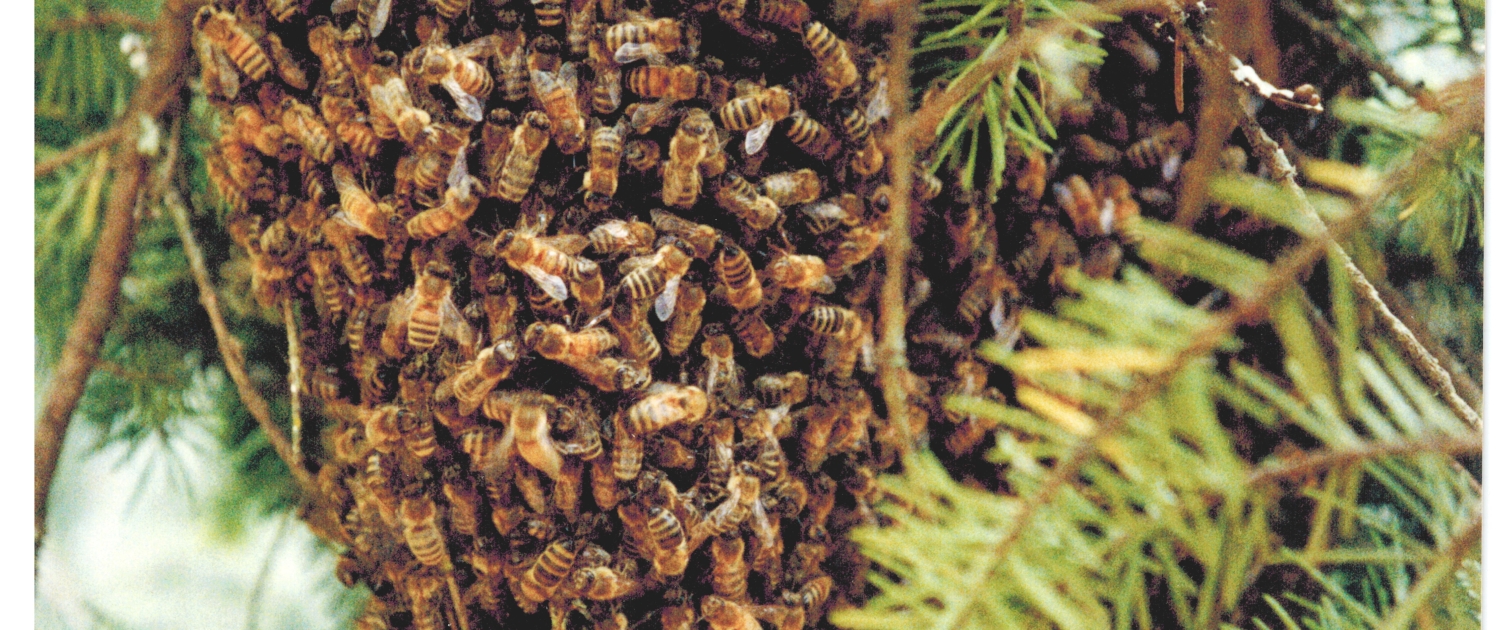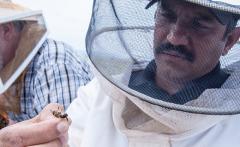What Makes Our Queens Unique…

These posts are all educational in some nature, with a variety of topics.

OWA Checklist for Re queening an Existing Colony
OUR QUEENS HAVE DIFFERENT PHEROMONES, REQUIRING SPECIAL PRECAUTIONS – BEFORE YOUR QUEENS ARRIVE, WE RECOMMEND:
A SPECIAL NOTE IF RE QUEENING IN THE FALL – OR DURING A DEARTH IN NECTAR FLOW: AVOID using feed stimulants containing additives like lemongrass, which can contribute to robbing.
WHEN YOUR QUEENS ARRIVE:
AFTER WAITING THE (6-24) HOURS …FOLLOW THESE STEPS TO INTRODUCE THE NEW QUEEN:
IMPORTANT: RETURN ON THE 4th DAY…
DO NOT DISTURB THE COLONY FOR AN ADDITIONAL 7 DAYS – EARLY DISTURBANCE CAN INCREASE THE RISK OF NON-ACCEPTANCE OR SUPERCEDURE!!!
August 2017 – Since most in the rest of Washington State are living with hot dry weather this summer, it may be difficult to imagine the unprecedented conditions we are experiencing here in the microclimate of our apiary.
Persistent smoke from wild fires just across the Straights of Juan de Fuca in British Columbia has pushed a continuous cool/foggy marine layer directly over our isolated mating yards preventing adequate mating conditions here on the North Olympic Peninsula.
In 20 years we have never had to suspend orders due to lack of production, and we deeply regret having to do so now. We could not have predicted these unseasonably adverse weather conditions….check back here later in the season.
OWA maintains isolated mating yards in a very remote area of the Olympic Peninsula of Washington State. Our drone colonies are selected for hygienic behavior, disease, and mite resistance. They are fed high quality pollen supplements, and are provided with additional drone combs to insure abundant populations.

Swarm
In 1997, when feral colonies were thought to be near extinction due to varroa mites, we began capturing wild honeybee swarms from very remote locations in the sparsely inhabited wilderness of the North Olympic Peninsula of Washington State.
…After decades of selective breeding for Nosema tolerance in the Danish strain, it appears these bees are tolerant to N. ceranae infections.
Varroa sensitive hygiene (VSH) is a behavioral trait of honey bees (Apis mellifera) in which bees detect and remove bee pupae that are infested by the parasitic mite Varroa destructor. V. destructor is considered to be the most dangerous pest problem for honey bees worldwide. VSH activity results in significant resistance to the mites.
Minimum of 95% removal of freeze-killed brood in 24 hours
This trait will reduce or eliminate Chalkbrood; AFB; and varroa mite levels w/o the use of chemical treatments
Varroa Mite Resistance
VSH trait is determined by Alcohol Wash Assay during spring brood build-up and fall peak mite infestation.
Grooming Behavior is determined by Alcohol Wash Assay during the winter broodless period
Nosema Tolerance
Demonstrate vigor with high exposure: UNTREATED.
Our selection process is verified by in-house microscopic testing and USDA Laboratory reports.
Hoarding Behavior
Excellent Honey producers
Heavy pollen collectors
Gentleness
No need for gloves
Swarming Behavior
Not prone to swarm
High Degree of Longevity & Solid Brood Patterns
http://www.ars.usda.gov/research/publications/publications.htm?seq_no_115=268796
Research Project: Breeding, Genetics, Stock Improvement and Management of Russian Honey Bees for Mite and Small Hive Beetle Control and Pollination
Location: Honey Bee Breeding, Genetics, and Physiology Research
Title: Patriline variation of Nosema ceranae levels in Russian and Italian honey bees
Authors
BOURGEOIS, LANIE
RINDERER, THOMAS
Sylvester, H
HOLLOWAY, BETH
Submitted to: Cold Spring Harbor Meeting
Publication Type: Abstract
Publication Acceptance Date: April 8, 2011
Publication Date: May 8, 2011
Citation: Bourgeois, A.L., Rinderer, T.E., Sylvester, H.A., Holloway, B.A. 2011. Patriline variation of Nosema ceranae levels in Russian and Italian honey bees. Cold Spring Harbor Meeting. 17.
Technical Abstract: The microsporidian Nosema ceranae has invaded managed honey bee colonies throughout the world. While the presence of N. ceranae is common, infection levels are highly variable, even among bees within a single colony. The underlying mechanisms driving this variation are not well-understood. The high degree of individual variation within a colony suggests some degree of genetic resistance to N. ceranae infections may exist among managed honey bee colonies. One likely source for this variation stems from the polygamous nature of honey bee queens, producing multiple patrilines within each colony. We investigated the relationship between infection levels of N. ceranae and patriline membership by sampling individual bees from colonies from both Russian and Italian stocks. A total of 720 bees were collected from 5 Russian and 5 Italian colonies. Individual bees were tested for N. ceranae infection levels using qPCR, and were genotyped to determine patriline membership. Levels of N. ceranae varied significantly at the stock level (Russian: 3.68 x 106 ± 1.88 x 106 nosema/bee and Italian: 9.14 x 106 ± 4.62 x 106 nosema/bee; P = 0.008) and at the colony level for both Russian (P = 0.002) and Italian (P = 0.003) bees. Patriline-based variance was evident among only the Russian bees (P = 0.024). There was substantial variation in N. ceranae levels among Italian bees, ranging from 0 to 2.12 x 109 nosema/bee, however this variation was not associated with patriline membership (P = 0.742). The variance in N. ceranae infection among Russian honey bee patrilines demonstrates a genetic basis for resistance to N. ceranae infection which conforms to predictions of models that relate patriline variance and abundance to disease resistance in honey bees. This difference between Russian and Italian honey bees may derive from Italian honey bees having only a short history of exposure to N. ceranae while Russian honey bees may have had 150 years of exposure.
Last Modified: 02/05/2012
 Bee researcher Ramesh Sagili inspects a European honey bee in a carrot seed field near Madras, Ore. Photo by Lynn Ketchum
Bee researcher Ramesh Sagili inspects a European honey bee in a carrot seed field near Madras, Ore. Photo by Lynn KetchumThe finding, published recently in the Journal of Insect Physiology, suggests that giving honey bees access to a greater quantity and variety of pollen—their only source of protein—could make them more resilient against parasites and other pests, and help to stem worrisome declines in bee populations.
History of OWA Russian Honeybees
Although we do consider “gentleness” to be a desirable characteristic in our selection process, we admit that our higher priority is for disease and mite resistance.
It is our philosophy that decades of selection for gentleness and honey production, and the use of synthetic miticides, may have diminished the honeybee’s natural ability to adapt to changing stressors.
While our Wild Survivor Bees may appear at times to be more defensive than other commercially available stock, most of our customers report them to be gentle; quiet on the comb; entirely manageable; and consistently demonstrate unparalleled hardiness in their inherent ability to withstand many of the pathogens affecting honeybees today without the need of harsh chemical treatments.
When working our bees, we recommend that you follow these simple practices:
*SIDE NOTE: We usually work our bees without gloves, in half-suits. Instead of using a smoker, we prefer the convenience of a pint-sized trigger sprayer filled with a mixture of approximately 16 oz of H2O to one ounce of liquid smoke (available in grocery stores), plus a few drops of lemon grass essential oil. A light misting when cracking open the colony lid; and an occasional spritz on our hands is very effective. It hangs easily on a pocket and we discovered by experience that it is much safer than keeping a smoker going… but that’s a story for another time 🙂
J Invertebr Pathol. 2012 Mar;109(3):297-302. Epub 2012 Jan 20. http://www.ncbi.nlm.nih.gov/pubmed/22285444
Sample#1 (FERAL BEES)
This is our strongest breeder colony. She is a 2009 Queen. Entirely untreated; has never exhibited symptoms of dwindling; and has had 4 to 5 brood combs removed and added to weaker colonies throughout the 2011 season, yet remains vigorous.
This colony has been tested in the USDA Beltsville Lab 4 times with these results:
Sample was also submitted to Dave Wick at BVS, Inc. Testing indicatd the presence of IAPV, CPV and Sac Brood virus. (Dave did confirm that IAPV and black queen cell virus are associated with n.ceranae, however he was not able to confirm that CPV is).
Only 5% of our 2011 colonies showed no sign of dwindling after their 4th cool; wet; protracted winter.
Now in the 5th spring since the devastating losses from this pathogen, our untreated bees are thriving in spite of staggering nosema spore loads and associated viruses, and we have had only 10% winter loss in 2011-2012.